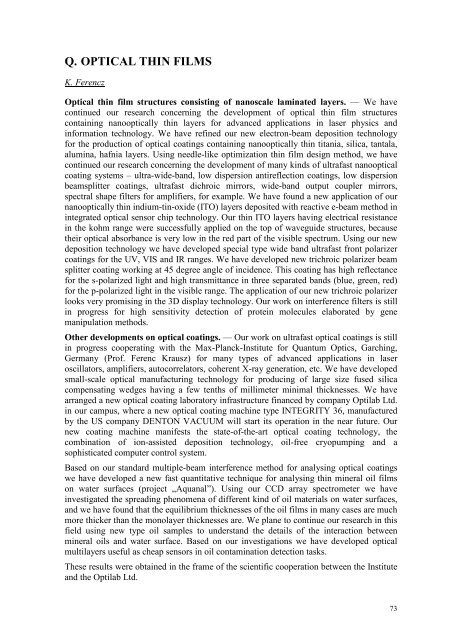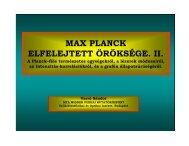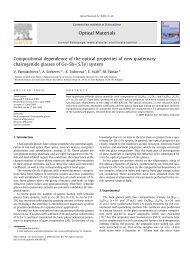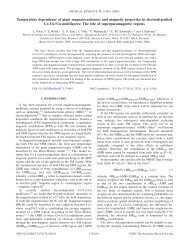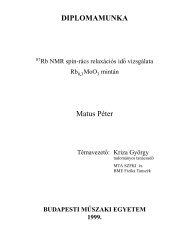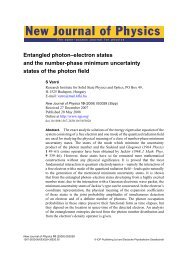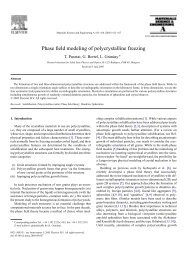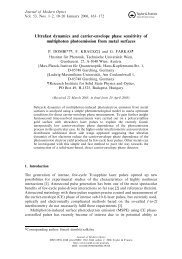ANNUAL REPORT - MTA SzFKI
ANNUAL REPORT - MTA SzFKI
ANNUAL REPORT - MTA SzFKI
You also want an ePaper? Increase the reach of your titles
YUMPU automatically turns print PDFs into web optimized ePapers that Google loves.
Q. OPTICAL THIN FILMS<br />
K. Ferencz<br />
Optical thin film structures consisting of nanoscale laminated layers. — We have<br />
continued our research concerning the development of optical thin film structures<br />
containing nanooptically thin layers for advanced applications in laser physics and<br />
information technology. We have refined our new electron-beam deposition technology<br />
for the production of optical coatings containing nanooptically thin titania, silica, tantala,<br />
alumina, hafnia layers. Using needle-like optimization thin film design method, we have<br />
continued our research concerning the development of many kinds of ultrafast nanooptical<br />
coating systems – ultra-wide-band, low dispersion antireflection coatings, low dispersion<br />
beamsplitter coatings, ultrafast dichroic mirrors, wide-band output coupler mirrors,<br />
spectral shape filters for amplifiers, for example. We have found a new application of our<br />
nanooptically thin indium-tin-oxide (ITO) layers deposited with reactive e-beam method in<br />
integrated optical sensor chip technology. Our thin ITO layers having electrical resistance<br />
in the kohm range were successfully applied on the top of waveguide structures, because<br />
their optical absorbance is very low in the red part of the visible spectrum. Using our new<br />
deposition technology we have developed special type wide band ultrafast front polarizer<br />
coatings for the UV, VIS and IR ranges. We have developed new trichroic polarizer beam<br />
splitter coating working at 45 degree angle of incidence. This coating has high reflectance<br />
for the s-polarized light and high transmittance in three separated bands (blue, green, red)<br />
for the p-polarized light in the visible range. The application of our new trichroic polarizer<br />
looks very promising in the 3D display technology. Our work on interference filters is still<br />
in progress for high sensitivity detection of protein molecules elaborated by gene<br />
manipulation methods.<br />
Other developments on optical coatings. — Our work on ultrafast optical coatings is still<br />
in progress cooperating with the Max-Planck-Institute for Quantum Optics, Garching,<br />
Germany (Prof. Ferenc Krausz) for many types of advanced applications in laser<br />
oscillators, amplifiers, autocorrelators, coherent X-ray generation, etc. We have developed<br />
small-scale optical manufacturing technology for producing of large size fused silica<br />
compensating wedges having a few tenths of millimeter minimal thicknesses. We have<br />
arranged a new optical coating laboratory infrastructure financed by company Optilab Ltd.<br />
in our campus, where a new optical coating machine type INTEGRITY 36, manufactured<br />
by the US company DENTON VACUUM will start its operation in the near future. Our<br />
new coating machine manifests the state-of-the-art optical coating technology, the<br />
combination of ion-assisted deposition technology, oil-free cryopumping and a<br />
sophisticated computer control system.<br />
Based on our standard multiple-beam interference method for analysing optical coatings<br />
we have developed a new fast quantitative technique for analysing thin mineral oil films<br />
on water surfaces (project „Aquanal”). Using our CCD array spectrometer we have<br />
investigated the spreading phenomena of different kind of oil materials on water surfaces,<br />
and we have found that the equilibrium thicknesses of the oil films in many cases are much<br />
more thicker than the monolayer thicknesses are. We plane to continue our research in this<br />
field using new type oil samples to understand the details of the interaction between<br />
mineral oils and water surface. Based on our investigations we have developed optical<br />
multilayers useful as cheap sensors in oil contamination detection tasks.<br />
These results were obtained in the frame of the scientific cooperation between the Institute<br />
and the Optilab Ltd.<br />
73


